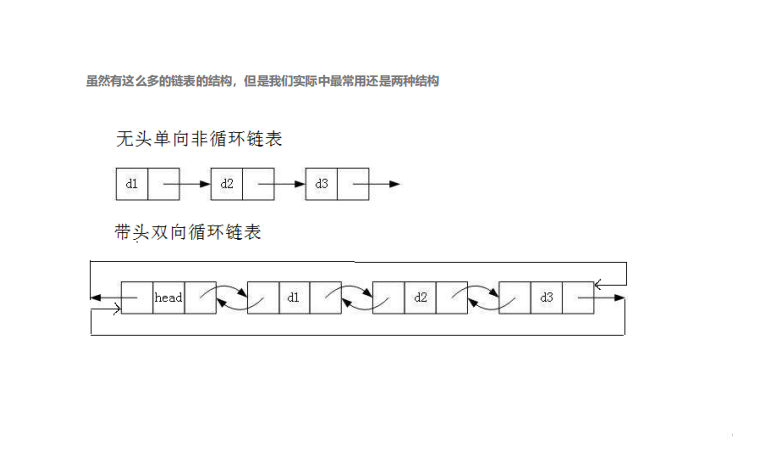无头+单向+非循环链表的实现
这里写目录标题
- 1. 链表
- 1.1 链表的概念及结构
- 1.2 链表的分类
- 2. 接口实现
- 3. 链表的实现
- 3.1 打印链表
- 3.2 头插
- 3.3 尾插
- 3.4 头删
- 3.5 尾删
- 3.6 单链表查找
- 3.7 在pos之前插入
- 3.8 在pos之后插入
- 3.9 删除pos位置的值
- 3.10 删除pos位置之后的值
- 3.11 链表的释放
- 3.12 动态申请一个节点
- 4. 链表的测试
- 4.1 尾插测试
- 4.2 空链表头插
- 4.3 尾删测试
- 4.4 查找修改测试
- 4.5 pos前插和后插以及删除pos位置的值
- 5. 整体代码
- 5.1 test.c 文件
- 5.2 SList.h 文件
- 5.3 SList.c 文件
1. 链表
1.1 链表的概念及结构
概念:链表是一种物理存储结构上非连续、非顺序的存储结构,数据元素的逻辑顺序是通过链表中的指针链接次序实现的 。



1.2 链表的分类
实际中链表的结构非常多样,以下情况组合起来就有8种链表结构:


- 无头单向非循环链表:结构简单,一般不会单独用来存数据。实际中更多是作为其他数据结构的子结构,如哈希桶、图的邻接表等等。另外这种结构在笔试面试中出现很多。
- 带头双向循环链表:结构最复杂,一般用在单独存储数据。实际中使用的链表数据结构,都是带头双向循环链表。另外这个结构虽然结构复杂,但是使用代码实现以后会发现结构会带来很多优势,实现反而简单了。
2. 接口实现
接口就是函数定义
#pragma once
#include <stdio.h>
#include <stdlib.h>
#include <assert.h>typedef int SLTDataType;
typedef struct SListNode
{SLTDataType data;//数据域struct SListNode* next;//指针域
}SLTNode;//打印链表
void SLTPrint(SLTNode* phead);//头插
void SLPushFront(SLTNode** pphead, SLTDataType x);//尾插
void SLPushBack(SLTNode** pphead, SLTDataType x);//头删
void SLPopFront(SLTNode** pphead);//尾删
void SLPopBack(SLTNode** pphead);//单链表查找
SLTNode* STFind(SLTNode* phead, SLTDataType x);//在pos之前插入
void SLInsert(SLTNode** pphead, SLTNode* pos, SLTDataType x);//在pos之后插入
void SLInsertAfter(SLTNode* pos, SLTDataType x);//删除pos位置的值
void SLErase(SLTNode** pphead, SLTNode* pos);//删除pos位置之后的值
void SLEraseAfter(SLTNode* pos);//链表的释放
void SLDestroy(SLTNode** pphead);
3. 链表的实现
3.1 打印链表
//打印链表
void SLTPrint(SLTNode* phead)
{SLTNode* cur = phead;while (cur){printf("%d->", cur->data);cur = cur->next;//找结构体下一个指针,循环才能走起来}printf("NULL\n");
}
3.2 头插
//头插
void SLPushFront(SLTNode** pphead, SLTDataType x)
{assert(pphead);//链表为空,pphead也不为空,因为它是头指针plist的地址//assert(*pphead);//不能断言,链表为空,也需要插入SLTNode* newnode = BuyLTNode(x);newnode->next = *pphead;*pphead = newnode;
}
3.3 尾插
//尾插
void SLPushBack(SLTNode** pphead, SLTDataType x)
{assert(pphead);//链表为空,pphead也不为空,因为它是头指针plist的地址//assert(*pphead);//链表为空,可以插入SLTNode* newnode = BuyLTNode(x);//空链表if (*pphead == NULL){*pphead = newnode;}//非空链表else{SLTNode* tail = *pphead;while (tail->next != NULL){tail = tail->next;}SLTNode* newnode = BuyLTNode(x);tail->next = newnode;}}
3.4 头删
//头删
void SLPopFront(SLTNode** pphead)
{assert(pphead);//链表为空,pphead也不为空,因为它是头指针plist的地址assert(*pphead);//空链表,不能头删一个节点//if (((*pphead)->next) == NULL)//{// free(*pphead);// *pphead = NULL;//}多个节点//else//{// SLTNode* head = *pphead;// *pphead = head->next;// free(head);//}SLTNode* del = *pphead;*pphead = del->next;free(del);
}
3.5 尾删
//尾删
void SLPopBack(SLTNode** pphead)
{//没有节点(空链表)//暴力检查assert(*pphead);//一个节点if (((*pphead)->next) == NULL){free(*pphead);*pphead = NULL;}else{//多个节点SLTNode* tail = *pphead;//找尾while (tail->next->next){tail = tail->next;}free(tail->next);tail->next = NULL;}
}
3.6 单链表查找
//单链表查找
SLTNode* STFind(SLTNode* phead, SLTDataType x)
{SLTNode* cur = phead;while (cur){if (cur->data == x){return cur;}cur = cur->next;}return NULL;
}
3.7 在pos之前插入
//在pos之前插入
void SLInsert(SLTNode** pphead, SLTNode* pos, SLTDataType x)
{assert(pphead);assert(pos);if (*pphead == pos){SLPushFront(pphead, x);}else{SLTNode* prev = *pphead;while (prev->next != pos){prev = prev->next;}SLTNode* newnode = BuyLTNode(x);prev->next = newnode;newnode->next = pos;}
}
3.8 在pos之后插入
//在pos之后插入
void SLInsertAfter(SLTNode* pos, SLTDataType x)
{SLTNode* newnode = BuyLTNode(x);newnode->next = pos->next;pos->next = newnode;
}
3.9 删除pos位置的值
//删除pos位置的值
void SLErase(SLTNode** pphead, SLTNode* pos)
{assert(pphead);assert(pos);if (*pphead == pos){SLPopFront(pphead);}else{SLTNode* prev = *pphead;while (prev->next != pos){prev = prev->next;}prev->next = pos->next;free(pos);}
}
3.10 删除pos位置之后的值
//删除pos位置之后的值
void SLEraseAfter(SLTNode* pos)
{assert(pos);assert(pos->next);SLTNode* next = pos->next;pos->next = next->next;free(next);
}
3.11 链表的释放
//链表的释放
void SLDestroy(SLTNode** pphead)
{assert(pphead);SLTNode* cur = *pphead;while (cur){SLTNode* next = cur->next;free(cur);cur = next;}*pphead = NULL;
}
3.12 动态申请一个节点
//动态开辟一个newnode结构体,不free不释放
SLTNode* BuyLTNode(SLTDataType x)
{SLTNode* newnode = (SLTNode*)malloc(sizeof(SLTNode));if (newnode == NULL){perror("BuyLTNode");return NULL;}newnode->data = x;newnode->next = NULL;return newnode;
}
4. 链表的测试
4.1 尾插测试
//尾插测试
void TestSLish1()
{SLTNode* plist = NULL;SLPushFront(&plist, 1);SLPushFront(&plist, 2);SLPushFront(&plist, 3);SLPushFront(&plist, 4);SLTPrint(plist);SLPushBack(&plist, 5);SLTPrint(plist);
}int main()
{TestSLish1();return 0;
}
运行演示:

4.2 空链表头插
//空链表头插
void TestSLish2()
{SLTNode* plist = NULL;SLPushBack(&plist, 1);SLPushBack(&plist, 2);SLPushBack(&plist, 3);SLPushBack(&plist, 4);SLPushBack(&plist, 5);SLTPrint(plist);
}int main()
{TestSLish2();return 0;
}
运行演示:

4.3 尾删测试
//尾删测试
void TestSLish3()
{SLTNode* plist = NULL;SLPushBack(&plist, 1);SLPushBack(&plist, 2);SLPushBack(&plist, 3);SLPopBack(&plist);SLTPrint(plist);SLPopBack(&plist);SLTPrint(plist);SLPopBack(&plist);SLTPrint(plist);
}int main()
{TestSLish3();return 0;
}
运行演示:

4.4 查找修改测试
//查找修改测试
void TestSLish4()
{SLTNode* plist = NULL;SLPushBack(&plist, 1);SLPushBack(&plist, 2);SLPushBack(&plist, 3);SLPushBack(&plist, 4);SLPushBack(&plist, 5);SLTPrint(plist);SLTNode* pos = STFind(plist, 3);if (pos)pos->data = 30;SLTPrint(plist);
}int main()
{TestSLish4();return 0;
}
运行演示:

4.5 pos前插和后插以及删除pos位置的值
//pos前插和后插,测试
//删除pos位置的值
void TestSLish5()
{SLTNode* plist = NULL;SLPushBack(&plist, 1);SLPushBack(&plist, 2);SLPushBack(&plist, 3);SLPushBack(&plist, 4);SLPushBack(&plist, 5);SLTPrint(plist);SLTNode* pos = STFind(plist, 3);if (pos){SLInsert(&plist, pos, 30);}SLTPrint(plist);pos = STFind(plist, 2);if (pos){SLInsertAfter(pos, 20);}SLTPrint(plist);pos = STFind(plist, 2);if (pos){SLErase(&plist, pos);}SLTPrint(plist);SLDestroy(&plist);
}int main()
{TestSLish5();return 0;
}
运行演示:

5. 整体代码
5.1 test.c 文件
#define _CRT_SECURE_NO_WARNINGS 1
#include "SList.h"//尾插测试
void TestSLish1()
{SLTNode* plist = NULL;SLPushFront(&plist, 1);SLPushFront(&plist, 2);SLPushFront(&plist, 3);SLPushFront(&plist, 4);SLTPrint(plist);SLPushBack(&plist, 5);SLTPrint(plist);
}//空链表头插
void TestSLish2()
{SLTNode* plist = NULL;SLPushBack(&plist, 1);SLPushBack(&plist, 2);SLPushBack(&plist, 3);SLPushBack(&plist, 4);SLPushBack(&plist, 5);SLTPrint(plist);
}//尾删测试
void TestSLish3()
{SLTNode* plist = NULL;SLPushBack(&plist, 1);SLPushBack(&plist, 2);SLPushBack(&plist, 3);SLPopBack(&plist);SLTPrint(plist);SLPopBack(&plist);SLTPrint(plist);SLPopBack(&plist);SLTPrint(plist);
}//查找修改测试
void TestSLish4()
{SLTNode* plist = NULL;SLPushBack(&plist, 1);SLPushBack(&plist, 2);SLPushBack(&plist, 3);SLPushBack(&plist, 4);SLPushBack(&plist, 5);SLTPrint(plist);SLTNode* pos = STFind(plist, 3);if (pos)pos->data = 30;SLTPrint(plist);
}//pos前插和后插,测试
//删除pos位置的值
void TestSLish5()
{SLTNode* plist = NULL;SLPushBack(&plist, 1);SLPushBack(&plist, 2);SLPushBack(&plist, 3);SLPushBack(&plist, 4);SLPushBack(&plist, 5);SLTPrint(plist);SLTNode* pos = STFind(plist, 3);if (pos){SLInsert(&plist, pos, 30);}SLTPrint(plist);pos = STFind(plist, 2);if (pos){SLInsertAfter(pos, 20);}SLTPrint(plist);pos = STFind(plist, 2);if (pos){SLErase(&plist, pos);}SLTPrint(plist);SLDestroy(&plist);
}int main()
{TestSLish1();return 0;
}
5.2 SList.h 文件
#pragma once
#include <stdio.h>
#include <stdlib.h>
#include <assert.h>typedef int SLTDataType;
typedef struct SListNode
{SLTDataType data;//数据域struct SListNode* next;//指针域
}SLTNode;//打印链表
void SLTPrint(SLTNode* phead);//头插
void SLPushFront(SLTNode** pphead, SLTDataType x);//尾插
void SLPushBack(SLTNode** pphead, SLTDataType x);//头删
void SLPopFront(SLTNode** pphead);//尾删
void SLPopBack(SLTNode** pphead);//单链表查找
SLTNode* STFind(SLTNode* phead, SLTDataType x);//在pos之前插入
void SLInsert(SLTNode** pphead, SLTNode* pos, SLTDataType x);//在pos之后插入
void SLInsertAfter(SLTNode* pos, SLTDataType x);//删除pos位置的值
void SLErase(SLTNode** pphead, SLTNode* pos);//删除pos位置之后的值
void SLEraseAfter(SLTNode* pos);//链表的释放
void SLDestroy(SLTNode** pphead);
5.3 SList.c 文件
#define _CRT_SECURE_NO_WARNINGS 1
#include "SList.h"//打印链表
void SLTPrint(SLTNode* phead)
{SLTNode* cur = phead;while (cur){printf("%d->", cur->data);cur = cur->next;//找结构体下一个指针,循环才能走起来}printf("NULL\n");
}//动态开辟一个newnode结构体,不free不释放
SLTNode* BuyLTNode(SLTDataType x)
{SLTNode* newnode = (SLTNode*)malloc(sizeof(SLTNode));if (newnode == NULL){perror("BuyLTNode");return NULL;}newnode->data = x;newnode->next = NULL;return newnode;
}//头插
void SLPushFront(SLTNode** pphead, SLTDataType x)
{assert(pphead);//链表为空,pphead也不为空,因为它是头指针plist的地址//assert(*pphead);//不能断言,链表为空,也需要插入SLTNode* newnode = BuyLTNode(x);newnode->next = *pphead;*pphead = newnode;
}//尾插
void SLPushBack(SLTNode** pphead, SLTDataType x)
{assert(pphead);//链表为空,pphead也不为空,因为它是头指针plist的地址//assert(*pphead);//链表为空,可以插入SLTNode* newnode = BuyLTNode(x);//空链表if (*pphead == NULL){*pphead = newnode;}//非空链表else{SLTNode* tail = *pphead;while (tail->next != NULL){tail = tail->next;}SLTNode* newnode = BuyLTNode(x);tail->next = newnode;}}//头删
void SLPopFront(SLTNode** pphead)
{assert(pphead);//链表为空,pphead也不为空,因为它是头指针plist的地址assert(*pphead);//空链表,不能头删一个节点//if (((*pphead)->next) == NULL)//{// free(*pphead);// *pphead = NULL;//}多个节点//else//{// SLTNode* head = *pphead;// *pphead = head->next;// free(head);//}SLTNode* del = *pphead;*pphead = del->next;free(del);
}//尾删
void SLPopBack(SLTNode** pphead)
{//没有节点(空链表)//暴力检查assert(*pphead);//一个节点if (((*pphead)->next) == NULL){free(*pphead);*pphead = NULL;}else{//多个节点SLTNode* tail = *pphead;//找尾while (tail->next->next){tail = tail->next;}free(tail->next);tail->next = NULL;}
}//单链表查找
SLTNode* STFind(SLTNode* phead, SLTDataType x)
{SLTNode* cur = phead;while (cur){if (cur->data == x){return cur;}cur = cur->next;}return NULL;
}//在pos之前插入
void SLInsert(SLTNode** pphead, SLTNode* pos, SLTDataType x)
{assert(pphead);assert(pos);if (*pphead == pos){SLPushFront(pphead, x);}else{SLTNode* prev = *pphead;while (prev->next != pos){prev = prev->next;}SLTNode* newnode = BuyLTNode(x);prev->next = newnode;newnode->next = pos;}
}//在pos之后插入
void SLInsertAfter(SLTNode* pos, SLTDataType x)
{SLTNode* newnode = BuyLTNode(x);newnode->next = pos->next;pos->next = newnode;
}//删除pos位置的值
void SLErase(SLTNode** pphead, SLTNode* pos)
{assert(pphead);assert(pos);if (*pphead == pos){SLPopFront(pphead);}else{SLTNode* prev = *pphead;while (prev->next != pos){prev = prev->next;}prev->next = pos->next;free(pos);}
}//删除pos位置之后的值
void SLEraseAfter(SLTNode* pos)
{assert(pos);assert(pos->next);SLTNode* next = pos->next;pos->next = next->next;free(next);
}//链表的释放
void SLDestroy(SLTNode** pphead)
{assert(pphead);SLTNode* cur = *pphead;while (cur){SLTNode* next = cur->next;free(cur);cur = next;}*pphead = NULL;
}
